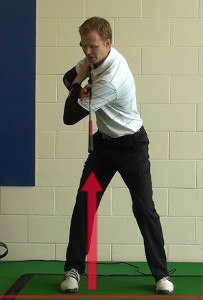
Shortened Backswing
The backswing is a critical part of the golf swing, and getting it right is essential for consistent and powerful ball striking. One common issue that golfers face is not taking the club back far enough in their backswing. This can lead to a lack of power, inconsistent ball striking, and a restricted swing.
Causes:
- Lack of shoulder turn: Many golfers fail to rotate their shoulders sufficiently during the backswing. This limits the amount of coil and potential energy that can be stored in the body, resulting in a shorter backswing.
- Restricted hip turn: Inefficient hip rotation can prevent a full and unrestricted backswing. Limited hip turn often occurs due to poor flexibility or incorrect weight distribution, where too much weight remains on the front foot during the backswing.
- Tension and tightness: Excessive tension in the arms, hands, and upper body can restrict the range of motion in the backswing. This tension can be caused by anxiety, lack of confidence, or a rushed and hurried swing.
Cures:
- Develop a full shoulder turn: Focus on rotating your shoulders fully during the backswing. Feel the stretch in your back and shoulders as you coil your upper body away from the target. This will create more power and enable a longer backswing.
- Engage your hips: Allow your hips to rotate freely during the backswing. Start by turning your front hip away from the target, allowing your back hip to naturally follow. This will create a more substantial turn and increase your range of motion.
- Relax and stay loose: Avoid tension and tightness in your swing. Practice relaxation techniques, such as deep breathing and visualization, to help calm your mind and body before each swing. Stay loose and supple throughout the swing, allowing for a full and fluid backswing.
- Practice drills: Use drills and exercises to reinforce a proper backswing. One useful drill is the “toe-up” drill, where you focus on keeping the clubhead pointing up towards the sky during the early stages of your backswing. This promotes a more extended takeaway and encourages a fuller backswing.
- Seek professional instruction: If you're struggling with your backswing, consider working with a golf instructor who can provide personalized guidance and feedback. They can help identify any specific swing faults and provide tailored drills and exercises to improve your backswing.
A shortened backswing is a common error that many golfers make, and it can have a negative impact on the consistency and power of their shots. When the backswing is too short, it often leads to a lack of coil, limited clubhead speed, and a restricted follow-through. Here are some causes and cures for a shortened golf backswing:
Causes:
- Lack of flexibility: Limited flexibility, particularly in the shoulders, hips, and spine, can restrict the range of motion during the backswing. This can result in a shortened swing as the body is unable to rotate fully.
- Fear of losing control: Some golfers may be hesitant to take a full backswing due to concerns about maintaining control over the club and hitting errant shots. This fear can lead to a cautious and shortened swing.
- Poor sequencing and timing: Inefficient sequencing and timing in the swing can disrupt the flow and prevent a full backswing. This can occur when the lower body initiates the downswing too early, cutting short the backswing.
Cures:
- Improve flexibility: Work on increasing flexibility in key areas of the body, such as the shoulders, hips, and spine. Incorporate stretching exercises and regular mobility work into your training routine to enhance your range of motion and allow for a fuller backswing.
- Practice with a mirror or video feedback: Utilize a mirror or video recording to observe your swing and check the length of your backswing. Seeing yourself from different angles can provide visual feedback and help you identify any areas where you may be shortening your swing.
- Develop a confident mindset: Overcoming the fear of losing control requires a shift in mindset. Focus on trusting your swing mechanics, practicing proper technique, and gradually increasing the length of your backswing. Building confidence will allow you to swing more freely and achieve a fuller motion.
- Work on sequencing and timing: Practice proper sequencing and timing in your swing to ensure a smooth transition from the backswing to the downswing. This involves starting the downswing with the lower body while maintaining the width and extension in your backswing.
Remember, a proper backswing sets the foundation for a successful golf swing. By addressing any issues with taking the club back far enough, you can unlock more power, consistency, and control in your game. Practice regularly, focus on your technique, and be patient as you work on improving your backswing.





